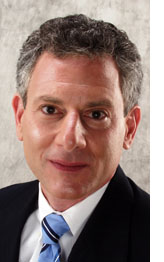| |
|

NOW-SUNDAY, SEPTEMBER 7

SUNDAY, AUGUST 24
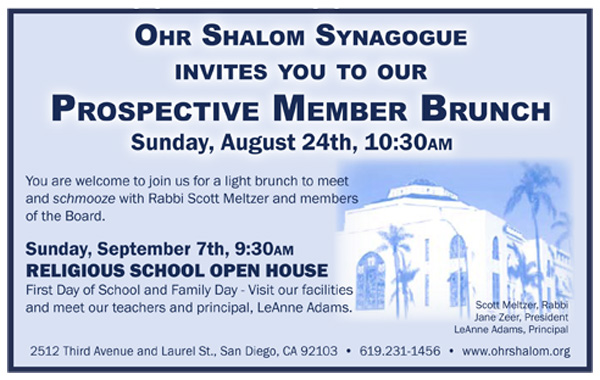
MONDAY, SEPTEMBER 1

.
FRIDAY, SEPTEMBER 12, 2008 Temple Solel S'more Shabbat
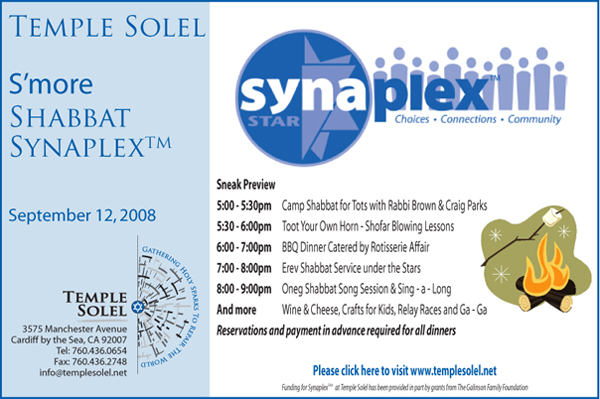
________________________________________________________
MON., SEPT. 29-THURS., OCT. 9


LETTER FROM JERUSALEM
Do missile defense systems really defend?
By Ira Sharkansky
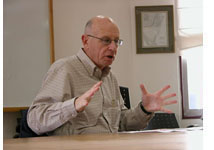 JERUSALEM—There are similarities between the United States decision to position anti-missile missiles in Eastern Europe, and the concerns of Israelis about threats from north, south, and elsewhere. JERUSALEM—There are similarities between the United States decision to position anti-missile missiles in Eastern Europe, and the concerns of Israelis about threats from north, south, and elsewhere.
An article in Economist ponders the wisdom of provoking the Russians with defensive missiles when there is no assurance that they will work.
The technical elements of the dispute are beyond us simpletons. We can read about advocates and skeptics, each claiming professional expertise, and do little more than wonder about their motives and certainties.
Likewise among Israelis who point to threats from Hamas, Hizbollah, al-Qaeda, as well as ordinary Arabs not affiliated with any organization who seize a knife or bulldozer and set forth to kill Jews.
Just this week the media highlighted a warning from a government organization concerned with combating terror. It said that Hizbollah is well advanced in plans to seize Israelis traveling abroad, but it could not identify the locations where the kidnapping might take place. It named several broadly defined areas, such as West Africa, Southeast Asia, South America and parts of Turkey, but did not rule out danger in the rest of the world.
What to do? Stay home? Perhaps under the bed and hope for the best? Should we tell recent graduates of the IDF to cancel their overseas hike? Or assume that the odds are with them, and that they are likely to be more cautious and capable than the average tourists.
How much to invest in protecting ourselves against possible harm? According to the Economist, the United States has spent $110 billion on missile defenses since Ronald Reagan launched "Star Wars" 25 years ago. The system designed for Eastern Europe is likely to cost another $10 billion per year. Israel has its own advocates of missile defense. There are competing systems claiming to defend against the kind of missiles launched from Lebanon in 2006 or those made in the workshops of Gaza and launched against nearby settlements. Skeptics note that the Israeli inventions are yet to be tested against a real attack, and are likely to cost hundred of thousands of dollars per shot against missiles that range in price from $50 to $100.
Both the United States and Israel can threaten unsustainable damage if attacked. Is that not enough, as against all the money spent on technically sophisticated defenses that might not work, or can be overwhelmed by lots of cheaper weapons?
Must the residents of Sderot remain frightened of a missile falling near them? How many soldiers should Israel be prepared to sacrifice in an invasion of Gaza that might lessen the threat of those missiles? Or how many Palestinian civilians should Israel be prepared to kill in air attacks that could bring international sanctions for violations of international law?
The threats against the United States and Israel are only potential. Both countries are enjoying a period of relative calm. Should the United States provoke adversaries by agreeing to position missiles of doubtful effectiveness in Eastern Europe? Should Israel make a pre-emptive strike against Hizbollah missiles in Lebanon that have not been used, or an even more daring raid against Iranian nuclear facilities?
Both Americans and Israelis hear frequent tales of impending doom and the proposals of politicians, soldiers, scientists, and engineers who are certain of efforts that should be made to counter the threats.
It is tempting to wait for the dangers to be more immediate, and look elsewhere for less awesome reports. Perhaps something about a politician's sexual adventures or financial scam. Yet when an Israeli looks elsewhere, the story might feature the possibility of Judaism disappearing through emigration from Israel and assimilation in the Diaspora. Americans could find yet another report about a newly diagnosed medical syndrome that demands treatment.
CAMPAIGN 2008
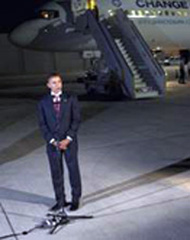 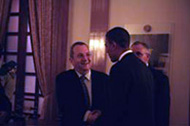 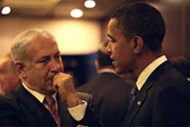
Tracking Obama's positions on Israel
By Ambassadors Dennis Ross and Daniel Kurtzer
WASHINGTON, D.C. —In late July, Senator Obama traveled to Israel to meet with Israel’s leaders, to express his unequivocal commitment to Israel’s security and to strengthening the U.S.-Israel relationship. In his meetings with Israeli officials, Senator Obama reaffirmed his longstanding belief that Israel's security is "sacrosanct," and reiterated his commitment to the steadfast relationship between the United States and Israel. Senator Obama traveled to Sderot to express his support and deep concern for the innocent victims of terror perpetrated by Hamas. He met with Palestinian leaders in Ramallah and received an update on the progress of their ongoing talks, held a range of discussions with Israeli officials, and he offered support for their shared vision of achieving a secure peace.
As Senator Obama’s Middle East Policy Advisors, we were honored to accompany him on his trip, and we are eager to share with you a recap of his historic visit.
Upon arriving at Ben Gurion airport, the Senator expressed how pleased he was to be back in Israel and laid out his goals for this leg of his overseas mission:
“I want input and insight from Israel's leaders about how they see the current situation, I will share some of my ideas. The most important idea for me to reaffirm is the historic and special relationship between the United States and Israel. One that cannot be broken. One that I have affirmed throughout my career and one that I will intend to not only continue but actually strengthen in an Obama administration.”
Senator Obama arrived just hours after a terrorist bulldozer attack in Jerusalem, and he made the following statement in response:
“…It is just one more reminder of why we have to work diligently, urgently and in a unified way to defeat terrorism. There are no excuses and I am absolutely committed to working with the Israeli government to make sure that these kind of occurrences do not happen. And my thought and prayers go out to the families that have suffered as a consequence of today's vicious attacks.”
The next morning, Senator Obama began a packed day by sharing breakfast with current Israeli Defense Minister and former Prime Minister Ehud Barak. Their discussion about the serious threats that Israel and America face together in the region focused on Iran, Hezbollah, Hamas, and nuclear proliferation. Senator Obama reaffirmed his commitment to ensuring Israel’s security and standing up for Israel’s right to self-defense, and he made clear his determination to prevent Iran from acquiring nuclear weapons, which he described as a grave threat to both Israel and the United States.
Next Senator Obama met with Opposition Leader and Likud Party Chairman Binyamin Netanyahu. Senator Obama and former Prime Minister Netanyahu have met before, and their personal relationship is warm and friendly. After their meeting in 2007, when they discussed the threat posed by a nuclear Iran, Senator Obama authored and sponsored the “Iran Sanctions Enabling Act” [S.1430], a bill that makes it easier for state and local governments to divest their pension funds from Iran’s energy sector. Senator Obama’s bill has been called one of the most important pieces of legislation in the fight to stop Iran from attaining a nuclear weapon. It was recently approved by the Senate Banking Committee and awaits passage by the full Senate this fall.
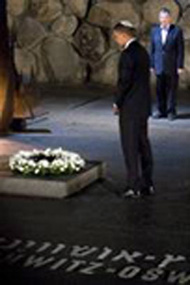 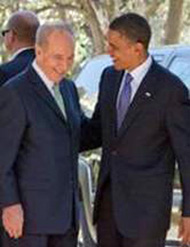 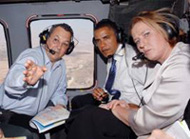
Senator Obama’s next stop was a somber one that brought a sharp reminder of the Jewish people’s tragic experiences in the twentieth century. He visited Yad Vashem (his second visit), Israel’s Holocaust memorial and museum. After touring the exhibits with the museum’s chairman, Senator Obama laid a wreath in the Hall of Remembrance and lit a flame in memory of the six million who perished at the hands of the Nazis. He expressed his intention to bring his children with him on his next visit to Yad Vashem, and then wrote poignantly in the memorial’s guestbook: “Let our children come here and know this history so they can add their voices to proclaim ‘Never Again.’ And may we remember those who perished, not only as victims but also as individuals who hoped and loved and dreamed like us and who have become symbols of the human spirit.”
Senator Obama then paid a visit to Israeli President and elder statesman Shimon Peres at his official residence. Senator Obama and President Peres enjoyed a productive meeting and spoke about how to build a better future for Israelis, Americans, and people throughout the world, through economic and technological development, as well as through the pursuit of peace. In a public appearance before their meeting, President Peres expressed his “high regard” for his guest, saying:
“They say the future belongs to the young -- they are wrong. The present belongs to the young. …Senator I read your two books and your articles and I do believe if you ask me what is my overall impression I would say a moving humanity. I was moved as a human man, a human being, and what we need is moving humanity in our time to overcome the problems to raise hope. The future [is] before you. The world, and so are we, [are] with you. God bless you."
Then, Senator Obama traveled to Ramallah to meet with Palestinian Authority President Mahmoud Abbas and Prime Minister Salam Fayyad. They discussed the progress of the current peace talks, the need for the Palestinians to fulfill their security obligations, and the opportunities for the next administration to help the parties build on the progress they have made.
Senator Obama then returned to Jerusalem and held discussions with Israeli Foreign Minister Tzipi Livni on Iran, peace talks with the Palestinians and Syria, and the threat from Hezbollah. The two of them, joined by Defense Minister Barak, then flew on an IDF helicopter to Sderot. For the residents of this southern Israeli town, terrorism has been a daily event. Senator Obama visited a family in their home which had been destroyed by one of the Qassam rockets that Hamas has been raining down on Sderot’s houses, schools, and playgrounds, and met an eight year-old boy who had lost a leg in one of the attacks. Standing in front of a collection of mangled Qassam rockets, Senator Obama expressed his admiration for the resilience and courage of those who have had to endure this daily onslaught by Hamas and his commitment to Israel’s right to defend its citizens from terrorism:
“The State of Israel faces determined enemies who seek its destruction. But it also has a friend and ally in the United States that will always stand by the people of Israel. That's why I'm proud to be here today and that's why I will work from the moment that I return to America, to tell the story of Sderot and to make sure that the good people who live here are enjoying a future of peace and security and hope.”
“If somebody was sending rockets into my house where my two daughters sleep at night, I’m going to do everything in my power to stop that. And I would expect Israelis to do the same thing.”
“…We don't need a peace deal just to have a piece of paper that doesn't result in peace. We need something that's meaningful. And it's not going to be meaningful if Israel's security is not part of that package. …So, my job is to -- if I'm the President, my job and my team's job is not to dictate to either of the parties what this deal should be, but hopefully to be able to facilitate and promote a meaningful, realistic, pragmatic, concrete strategy for achieving these goals.”
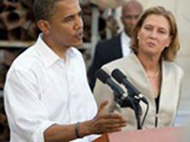 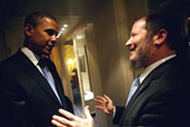 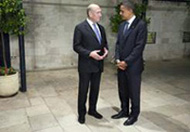
During his trip, Senator Obama also reached out to the Goldwasser and Regev families to offer his condolences for their loss, and he spoke with the Shalit family to express his hope and support that Galit is returned home safely. Later in Jerusalem, Senator Obama met with Mayor Uri Lupolianski and with two of the victims of the terrorist attack in Jerusalem the previous day, before sitting down for dinner with Israeli Prime Minister Ehud Olmert. They held a productive discussion about a range of issues, and Senator Obama reassured the Prime Minister that any future U.S. Administration would work to strengthen the special relationship with the State of Israel, and that he and the prime minister agree on the priority of preventing Iran from succeeding in its pursuit of nuclear weapons.
Senator Obama told his interlocutors in Israel that he understands that Iran poses an existential threat to Israel and the United States. This is a message he carried with him in the days that followed to Europe, where he commended the work of the EU 3 on pressuring Iran and spoke to leaders in Berlin, Paris, and London about how the international community needs to work together urgently to prevent a nuclear Iran.
Senator Obama’s meetings in Israel laid the groundwork for his discussions in Europe, and he will make it a priority in an Obama Administration to restore America’s role as a global leader on this issue. In his speech in Berlin, attended by over 200,000 people, Senator Obama drew on what he heard from leaders in Israel and saw during his visit to Yad Vashem when he declared:
“This is the moment we must help answer the call for a new dawn in the Middle East. My country must stand with yours and with Europe in sending a direct message to Iran that it must abandon its nuclear ambitions. We must support the Lebanese who have marched and bled for democracy, and the Israelis and Palestinians who seek a secure and lasting peace.
…Now the world will watch and remember what we do here - what we do with this moment. Will we extend our hand to the people in the forgotten corners of this world who yearn for lives marked by dignity and opportunity; by security and justice?
…Will we stand for the human rights of the dissident in Burma, the blogger in Iran, or the voter in Zimbabwe? Will we give meaning to the words "never again" in Darfur?”
Senator Obama believes strongly that much tougher economic sanctions than have been employed thus far can be effective against Iran, especially if coupled with the offer of incentives that would be available to Iran if they end their nuclear program, support for terrorism, and threats against Israel. At the same time, Senator Obama has said that he will take no option off the table when it comes to preventing Iran from acquiring nuclear weapons. The current administration’s policy of weak sticks and weak carrots has not worked and cannot work. A policy of strong sticks and strong carrots--one that raises the costs to the Iranians to the point where they have to make a choice--is the policy that is needed. And, this is precisely the point Senator Obama made with European leaders; a point that was made more poignant by the impressions he passed on from Israeli leaders who understandably view Iran with nuclear weapons as an existential threat.
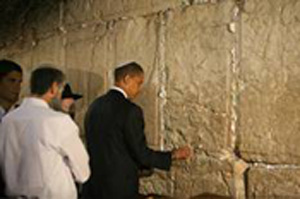 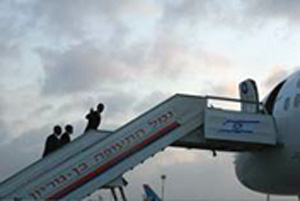
Senator Obama made one final stop before his departure to Europe. He was honored to visit the Western Wall, in the heart of Jerusalem’s Old City to pray and reflect on his visit and the challenges ahead. After the Western Wall Chief Rabbi, Shmuel Rabinovitz, led a prayer of Psalm 122, Senator Obama spent a personal moment at the Wall and slipped a personal note of prayer between the stones. He departed Israel for Europe that morning to continue his overseas trip, but he left a lasting impression on the Israeli people and the leaders he met with on his visit.
We have spent years in the Middle East working with regional leaders to tackle difficult issues of peace, security, and international cooperation. Traveling with Senator Obama afforded us the opportunity to observe his interactions with Israeli and Palestinian leaders, and our immediate impression was a profound admiration for his depth of understanding and fluency with all of the key issues and players involved.
We encourage you to forward this column to everyone you know who may have missed the coverage of Senator Obama’s historic visit so they can read and see for themselves the strong connection he has forged with the people of Israel and their leaders.
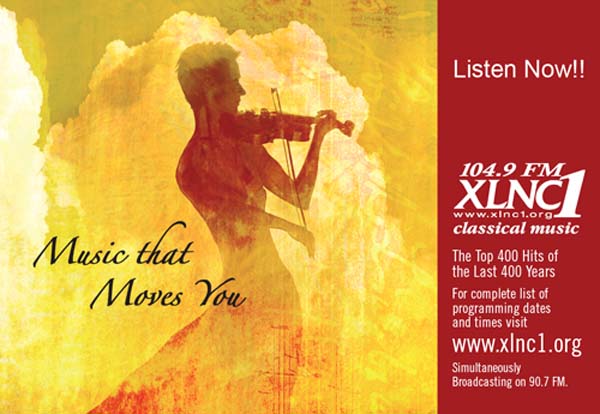

TORAH ON ONE FOOT
Judaism's tradition of putting study first
By Rabbi Leonard Rosenthal
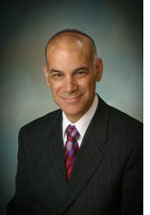 SAN DIEGO— Parashat Eikev contains the middle paragraph of the Shema (you know, the one that most of us skip!): SAN DIEGO— Parashat Eikev contains the middle paragraph of the Shema (you know, the one that most of us skip!):
"If, then, you obey the commandments that I enjoin upon you this day, loving the Lord your God and serving Him with all your heart and soul...." (Deut. 11:13-21)
In the middle of this paragraph Moses once again tells us about the importance of teaching our children Torah:
"Therefore impress these My words upon your very heart: bind them as a sign on your hand and let them serve as a symbol on your forehead, and teach them to your children-reciting them when you stay at home and when you are away, when you lie down and when you get up; and inscribe them on the doorposts of your house and on your gates." (Deut. 11:18-20)
Education has always been an important Jewish value. Even Jews who are not religiously observant want their children to become educated. Education is seen not only as an indicator of future success but as an end in itself.
The great rabbinic scholar known as the Chazon Ish made his way to Israel and settled in B'nai B'rak in 1933. He soon acquired a tremendous following. People sought him out as a teacher, judge, and advisor.
One day a group of local rabbis and leaders sought the Chazon Ish's advice on improving the level of Jewish education in B'nai B'rak. The Chazon Ish told them that the way to do this was by not just to make educating children in Torah a priority, but the highest priority. He told them a story about the Jew who approached the Chafetz Chaim and asked him to bless him with success in educating children.
The Chafetz Chaim looked at the man and said to him: "Do you really think a blessing will make you successful in this endeavor? No! Here is what you need to do: you must sell everything your own, sparing nothing, and use the money to purchase books and hire the best teachers for your children. The only way to successfully educate your children is to make it not your highest priority, but your only priority!" (Parparot shel Torah, Devarim, p. 86-87)
Many Jewish families I know, especially of my grandparents' and parents' generations, have intuitively followed the Chafetz Chaim's advice, even if they had never heard the story. They worked hard to provide for their children's education, often sacrificing their own needs so their children could receive the best.
However, the Talmud's story about Hillel reminds us that one should not only sacrifice for our children's education, but for one's own education as well:
Hillel the Elder was a poor man. He worked every day and earned only a dinar. He gave half of this to the guard at the house of study (to maintain the facility) and used the other half to support himself and his family.
One day, on the Sabbath eve, he earned no money, and the guard at the house of study would not permit him to enter. He climbed up to the roof and put his head against the skylight, where he could hear the words spoken by the sages Shemaiah and Avtalyon. As he lay on the roof, heavy snow began to fall on him, but Hillel remained in his place all night.
Next morning, Shemaiah said to Avtalyon: "Brother, this house is light every day, but today it is dark. Is it, perhaps, cloudy outside?"
They looked up and saw the figure of a man in the skylight. They climbed to the roof and found Hillel, covered with snow and almost frozen to death. They carried him down, bathed and anointed him, and placed him near the fire.
They said, "This man is worthy of having the Sabbath profaned because of him."
The rabbi taught: If a person comes before the heavenly court and says: "I was too poor and busy earning my livelihood to study," he is asked: "Were you poorer than Hillel?" (Babylonian Talmud, Yoma, page 35b. Translation by Francine Klagsburn in "Voices of Wisdom", p. 249)
This story reminds us not only of the importance of educating ourselves, but of the need to remove impediments from anyone who wishes to study Torah, young and old alike.

l.

AMAZING STORIES OF JUDAISM
Remembering Rav. Henach Leibowitz
By Rabbi Baruch Lederman
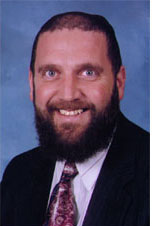 SAN DIEGO—The following tribute to the Rosh Yeshiva zt"l, submitted by Josh Lintz, was related by Avrohom Birnbaum: SAN DIEGO—The following tribute to the Rosh Yeshiva zt"l, submitted by Josh Lintz, was related by Avrohom Birnbaum:
Speaking to a talmid of the rosh yeshiva, Rav Henach Leibowitz zt"l, just hours after his passing and minutes before press time, was a lesson in and of itself. The talmid, a prominent, decade's long marbitz Torah, was completely brokenhearted. The first few minutes of the interview was akin to the heart-rending sobs of a person who just lost his
father. This talmid, not an overly emotional person by any means, simply cried deep, bitter sobs. The rosh yeshiva was over ninety, yet this talmid, a talmid who himself has
hundreds and perhaps thousands of his own talmidim, couldn't come to terms with the news of the rosh yeshiva's passing.
Finally, he composed himself and said, "You need words, not just cries. But how can one say anything about one's father? The rosh yeshiva was our rebbi - our rebbi muvhak, a gaon, a teacher and a mentor, but most of all, we felt he was our father."
"The love, the unabashed paternal love, that he showed, which he expressed to me, personally and to every other talmid in a most personal way, al pi darko, was the powerful ahava not just of a rebbi, but of a true father. He was a father who constantly thought about us, constantly exulted in our triumphs, and was heartbroken over our sorrow. He was a father who understood the individual strengths and weaknesses of each student, cultivating each one so as to bring out the best in him; a father who educated with such a degree of ahava, such a level of encouragement and tailor-made guidance, that it was impossible not to be encouraged, spurred and moved, not just by the shiurim, both in Gemara and mussar, but through the "shiur ahava" that he showed both in his actions and his expressed words."
The talmid related that once, when he was in his early twenties, he came to pick up the rosh yeshiva and bring him to yeshiva to deliver his blatt shiur. Turning to his talmid, the rosh yeshiva addressed him by his first name saying, "I love you."
"This was not hyperbole, nor exaggeration in any way. The love the rosh yeshiva had for us was no less than the love any father has for his own biological children. Perhaps it was even more!"
While on the subject of the blatt shiur, the talmid began to yearningly recount the lessons learned during the shiur. "The purpose of the blatt shiur was not to give over a shtickel Torah, but rather to teach us how to think. The rosh yeshiva would come into the shiur and either read the Gemara himself or ask a talmid to read the Gemara. He would
approach the sugyah as if he had never seen it before in his life. There was no "muskamos" - no givens. Every question was legitimate. He eschewed superficiality and, in the deep derech of Slabodka mussar that he was mekabel from his father, the great gaon, Rav Dovid Leibowitz zt"l, he encouraged us to think, to ask, to challenge every premise until, through the constant give and take, questions and answers, a legitimate approach to the Gemara was forged."
"Oy," the talmid continued. "At the shiur, one saw the degree of savlonus, patience, with which the rosh yeshiva was endowed. His deep-seated anava, his tremendous humility - not a superficial, put-on humility, but a humility that stemmed from his very penimiyus - came to the fore during the blatt shiur."
"During the blatt shiur, the rosh yeshiva encouraged talmidim to question him. He wanted to reach the true depth of p'shat and therefore deeply desired that the talmidim challenge him. What humility! When young talmidim, teenagers, would forcefully ask a question or confront him with a sevara, no matter how trivial, his humility, his savlanus, patience, was just astounding, almost superhuman.
"He was a true gaon, the deepest of thinkers, but thought nothing of conceding a sevara to a teenage talmid! He had such a deep-seated middas ha'emes, that every sevara, regardless of who said it, was probed to its depth.
"The rosh yeshiva was a prince who embodied the Slabodka approach of mussar that he had received from his illustrious father, Rav Dovid, founder of the Chofetz Chaim Yeshiva, who passed away in 1941. His mussar shmuessen were not inspirational, motivational pep talks; they were shiurim in middos and chochmas hamussar. He taught
us how a Jew thinks, how a Jew should feel, and how a Jew should view other Jews and other human beings.
"The ultimate embodiment of the lessons which he imparted in his shmuessen, the rosh yeshiva possessed a nobility of spirit. His heart was one that pulsated with the deepest feelings for other human beings, a heart that felt the pain of others as if it were his own and rejoiced in the simcha of others as if it were his own."
The talmid recalls observing the way the rosh yeshiva interacted with the Italian barber in Forest Hills. "The honor that he accorded him is hard to describe. One would think that the rosh yeshiva was entertaining Roosevelt or Churchill. The way he conversed with people - the honor, the nobility. You had to see it, take it in and observe it to believe it. It was the royalty of Slabodka.
"I once was driving the rosh yeshiva somewhere and we saw an ambulance, sirens blaring, en route to an emergency. It was a squalid neighborhood in Brooklyn with no Jewish population. Seeing the ambulance, the rosh yeshiva began to exclaim, 'Oy, oy, an ambulance!' One could sense the intense pain he felt at the suffering of a fellow
human being. As we approached, we saw the EMTs wheeling a woman out on a gurney. 'Oy, a woman, oy, oy,' the rosh yeshiva kept saying. The tzaar, the pain, that he expressed upon the sight of a woman in some far-off Brooklyn neighborhood, the spontaneous manifestation of tzaar for a fellow human being's suffering, was such that I don't think I even feel the same pain when observing my own child's pain!"
"The rosh yeshiva's humility and connection with his talmidim was so deep, it defies description. I remember once, at the yeshiva's Chanukah chagiga, there was spirited singing and dancing that was to be followed by a Chanukah shmuess by the rosh yeshiva. The rosh yeshiva stood up for about a minute at the shtender that had been set
up for him on a stage, and then, with his tremendous ahava, looked at us and said, "I am too far and too high over here." He then walked down from the stage and sat in the middle of a circle of talmidim. That is how he addressed us. This was a typically natural, instinctive reaction for the rosh yeshiva. It was a mix of humility, ahava and chinuch all in one.
"About 16 years ago, the precarious financial plight of the yeshiva forced him to agree to be honored at the yeshiva's dinner. All the talmidim wondered what he would say and how he would approach such an event. At the dinner, the rosh yeshiva got up to speak. Deftly and masterfully, he took the spotlight off of himself and began to speak
about his father. He spoke about how his father had established the yeshiva and the unique mesorah that his father had given over. Only after the speech ended did the audience realize that the rosh yeshiva had succeeded in completely removing the focus from himself, his more than half a century of leadership of the yeshiva, and his own role in molding thousands of talmidim while placing the spotlight solely on his father.
"He was such a giant, yet so humble, that as a talmid I felt so small in his presence. How could you feel like anything in the presence of such greatness?
"On the other hand, the rosh yeshiva was 'so normal.' I would say that he was a gaon in normalcy. He so understood the human psyche. He understood that human beings have foibles and faults and could laugh at them. He understood our trials and tribulations and he possessed a sterling sense of humor. He would laugh with us. He taught
us how to laugh - at ourselves - and how to see the humor in life. He would dance with us and exult with us - with pure simcha - on Simchas Torah. On Yom Kippur, he would cry, cry and cry. Oy! How many boxes of tissues did he use on Yom Kippur?
"He was a mechanech of mechanchim who understood how to be mechanech generations of talmidim. He molded neshamos - not in a cookie-cutter model, but each talmid according to his own particular need."
The brokenhearted talmid concluded, "I will never forget the Rebbetzin's levaya. The Rebbetzin was the rosh yeshiva's equal partner in everything. The way that they lived together, in such a manner of Shechina sheruya beineihem, is simply indescribable.
"At the levaya, the rosh yeshiva said, 'I was maspid my mother, I was maspid my father, but how can I be maspid my Rebbetzin? Being maspid her is like being maspid myself. What she did, I did. We did everything together.'
"How can I be maspid the rosh yeshiva or say anything about him?" the talmid concluded. "Anything I and my chaveirim, fellow talmidim of the rosh yeshiva, have accomplished has been because of him. Anything that we have done in life, any accomplishment that we have gone on to achieve, is only because of him."
Dedicated by Yossi & Michelle Kleinman in honor of their daughter Sabrina.
.


REFLECTIONS
First Shabbat in Emanu-El's new home:
'We are finally facing Jerusalem'
By Sheila Orysiek
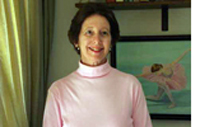 SAN DIEGO—The building which Temple Emanu-El inhabited for many years had previously been a church. It was old, worn, warm-hearted, dearly beloved, but it didn’t face Jerusalem. As the congregation grew - the building grew smaller and older. The decision to instigate a capital building fund was a big step. Some thought too big a step - where would all that money come from? Others were satisfied with the old - and comfortable - that with which they were familiar. But enough of the congregation led by Rabbi Martin Lawson, joined in his dream of a Sanctuary that was built to be a Jewish Sanctuary - one that would face Jerusalem from gestation to birth. SAN DIEGO—The building which Temple Emanu-El inhabited for many years had previously been a church. It was old, worn, warm-hearted, dearly beloved, but it didn’t face Jerusalem. As the congregation grew - the building grew smaller and older. The decision to instigate a capital building fund was a big step. Some thought too big a step - where would all that money come from? Others were satisfied with the old - and comfortable - that with which they were familiar. But enough of the congregation led by Rabbi Martin Lawson, joined in his dream of a Sanctuary that was built to be a Jewish Sanctuary - one that would face Jerusalem from gestation to birth.
One of our blessings is that we live in a country in which Jews can build a Sanctuary. There are far too many countries where this is prohibited and/or dangerous. Though we now face Jerusalem when we welcome in the Sabbath, when the service is over and we go home, were it not for the sanctuary our ancestors found here, we could not have lived to see the day where we can gather together and enjoy the fruits of our building.
Being relatively new to the congregation (only three years) I was soon caught up in the dream and watched as it came to fruition. For seventeen months we used a lovely chapel in a huge Methodist Church. Sometimes we used other facilities: a choir room, a lake in summer, the library in the Temple’s administration building, a classroom in the Temple’s school, an auditorium in a public elementary school as well as theater space (back stage for Torah Study - auditorium for Saturday morning services) - and other synagogues.
A very careful reading of the monthly bulletin was essential to try to decipher what was taking place where. One evening, getting my dates wrong I drove to three different locations until I finally heard people singing “Shalom Aleichem” and followed the sound. It was a microcosm of our history of the “wandering Jew.” But this time we were building, not fleeing.
All that is over. On Sunday, August 17, 2008, the new Sanctuary was ready to receive the Torah Scrolls which had also spent the preceding 17 months moving from place to place. The congregants came through the lovely wrought iron gates of leaves and pomegranates into a courtyard and then into the lobby of the Sanctuary. The outside of the building is faced with Jerusalem stone - a theme which is carried out in the wall behind the Bima. The stone truly comes from Jerusalem and has a rough surface and subtle color.
One of the things many in the congregation were fearful of losing was the feeling of warmth in the old Sanctuary. But it was immediately evident that though it is new and larger the intimacy of the old Sanctuary now resides in the new. The Rabbi doesn’t lead from the Bima - he is in our midst - as he prefers.
The new facility has also been commended for its environmentally friendly planning; conserving, recycling, using renewable and/or small footprint energy. It is also beautiful - there is color without distraction, blending in the light from stained glass windows both at ground level as well as just under the ceiling line. I don’t know if it was purposely planned but when the setting sun shines in the refracted light makes rainbows along those upper walls; like G-D’s promise to Noah. This seems particularly fitting as the theme is “Let justice roll down like waters.”
As we sat for the first time in the new Sanctuary and after a short but moving prayer reading by Rabbi Lawson, accompanied by the beautiful voice of Cantorial soloist Myrna Cohen, the Torah Scrolls were carried in under Chuppahs. This reminded me of the tents of Jacob and of the marriage of Israel to the Torah. As the Rabbi welcomed them, he grew tearful and said: “We are finally facing Jerusalem.”
While each Torah was placed in the new Ark, I couldn’t help but think of one of them which is a Survivor. Over two hundred years old, the scroll made of deer skin, it was buried by loving hands as the Nazi terror approached Eastern Europe. Eventually it was found and came to Temple Emanu-El in San Diego - albeit in an old church. But now it is at home in a building that was specifically built to house both it and the descendents of Sinai.
After the service, we adjourned to the courtyard to tables of catered desserts complete with ice cream and all the fixings. My husband and I stayed much longer than we originally had planned - it was hard to leave the congregants and what we had all built - yes, including me - caught up in a dream that began long before I had arrived.
The first Shabbat service in the new Sanctuary on August 22nd was particularly appropriate as it was the Rabbi and Anita’s 40th wedding anniversary. He has been the religious leader and heartbeat of this congregation for over thirty years, with Anita an active and loving partner. They took this opportunity to celebrate and thank the congregation but the thanks go just as strongly in the other direction. After the Shabbat Service we moved into the new community room for the wine and bread blessing and then continued the celebration with finger foods and baked pastries - much of it made by Anita and other members of the congregation.
But for me (as well as I love those pastries Anita makes) the highlight of the evening was the lighting of the Shabbat candles. Both as Rabbi and Rabbitzin and husband and wife, they blessed and lit the candles. It was happily teary and then someone called out: “You may now kiss the bride.” So he did. And I could see in her face that her answer is still “yes.”
Calling all Judaica artists


.


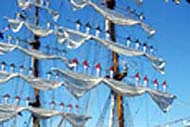  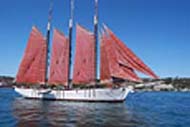
Tall ships on parade on San Diego Bay
By Dan Schaffer
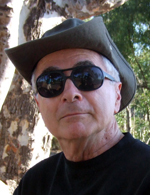 SAN DIEGO—The Maritime Museum of San Diego (MMSD) is not boxed up in a landlocked building. As so many San Diegans and visitors have been lucky enough to experience, the MMSD is housed in real ships and boats docked at the San Diego Embarcadero. The fleet started out with the Star of India and has grown to include, among others, a Russian attack submarine, the B-39; the Berkeley, an old San Francisco Bay ferry boat; and the Surprise, a replica of an18th-century British frigate used in the film Master and Commander. SAN DIEGO—The Maritime Museum of San Diego (MMSD) is not boxed up in a landlocked building. As so many San Diegans and visitors have been lucky enough to experience, the MMSD is housed in real ships and boats docked at the San Diego Embarcadero. The fleet started out with the Star of India and has grown to include, among others, a Russian attack submarine, the B-39; the Berkeley, an old San Francisco Bay ferry boat; and the Surprise, a replica of an18th-century British frigate used in the film Master and Commander.
This last week, the MMSD teamed up with ASTA, the American Sail Training Association, which sponsors the Tall Ship Challenge in ports on both coasts and on the Great Lakes. The Festival of Sail is more like a regatta than a race, but some of the same tall ships that paraded into our bay last Wednesday raced one another here from other ports up the coast.
I joined a press tour on the bay for an up-close viewing of the beautiful, impressive sailing ships. Even our press boat was historic. Built in San Diego in 1914, the Pilot has been here ever since. It served for many years as a pilot boat and is now a vehicle for student trips around the bay and, like the others in the MMSD, a tourist draw.
If you remember the weather last Wednesday, it was what used to be called a Patented San Diego Day: sunshine, cool breezes, and temperature in the mid 70’s.
The press contingent included a reporter from the San Diego Union-Tribune (the SDUT had a striking front-page color photo the next day, taken right next to me); a reporter and videographer from Fox Channel 5; the Museum of San Diego History’s photo archivist; a Port of San Diego press officer; and Maggie Walton, MMSD exhibit designer.
We sailed towards the harbor entrance, passing sunning sea lions, North Island aircraft carriers, Coast Guard zodiac craft, and various sailing and motor vessels along the way. Then we saw the first tall ship to enter the bay, the United States Coast Guard Cutter Eagle. From tip to tail, it’s almost 270 feet long, with a rig height of nearly 150 feet. The ship is used to train Coast Guard cadets. What a sight! It’s all white save for 2 angled stripes (red and blue, of course). It was built in the 1930s as a German Navy training ship. The U.S. Government acquired her after World War II as war reparations from Germany.
  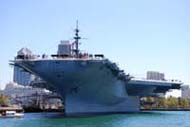
There were other impressive ships in the Festival of Sail, including the Surprise and a replica of the HMS Bounty from the 1962 Marlon Brando film. This year is the 220th anniversary of the Bounty’s first landing in Tahiti.
The most colorful ship was the American Pride, built as a Grand Banks commercial fisher in 1941, refurbished and restored in 1986, and now an educational center at the American Heritage Marine Institute in Long Beach. For those of you who recall truly old songs, this ship had red sails in the forenoon.
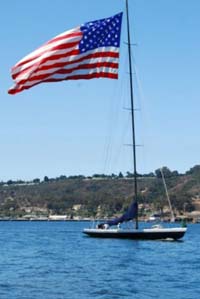 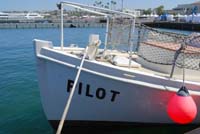 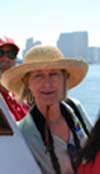
My favorite tall ship was another naval cadet trainer,the Gloria, built for the Colombian Navy in 1968. For the entire sail through the bay, the young sailors stood to attention on almost every available footing. Their national anthem resounded from an excellent sound system on board.
The rest of our cruise took us just north of the Coronado Bridge, passing very close to the Midway carrier museum. We disembarked at the Festival in progress. Large, large crowds, many vendors, happy faces, young and old filled the sidewalk along the pier.
Whenever San Diego Jewish World editor Don Harrison writes about local people and attractions, he looks for a Jewish angle. Mine was Jonathan, a 20-something Orthodox Jew from the Lower East Side of New York. He was one of the ASTA guides who helped the press people find their way to the Pilot. While in San Diego, he went to services at Beth Jacob Congregation and had dinner at The Place, a glatt-kosher restaurant in the College area.
If I hadn’t met Jonathan, I would have reached for tales about boats in the Bible, like Noah's Ark and Jonah’s ship. And I could have mentioned our Israelite ancestors who didn’t need tall ferries when Moses led them across the dry sea bed. But, as long as we have to deal with wet sea beds here in San Diego, those tall poles, canvas sheets and graceful hulls fill the space just fine.
The Festival of Sail concludes today. Your kids will love it almost as much as you do.

ADVENTURES IN SAN DIEGO JEWISH HISTORY
Editor's Note: To create a permanent and accessible archive, we are reprinting news articles that appeared in back issues of various San Diego Jewish newspapers. You may access an index of the headlines of those articles by clicking here. You may also use the Google search program on our home page or on the headline index page to search for keywords or names.
San Diego Birdie Stodel Chapter B’nai B’rith
From Southwestern Jewish Press, December 2, 1950, page 6
By Bess Borushek
Not only one orchid but a whole bouquet of orchids is hereby tendered the very capable committee who have successfully concluded the third donor luncheon held at the Hotel Del Coronado on November 21st. Our chapter can point with pride to having for the third consecutive year provided its donor guests with the most delectable of luncheons served in an inviting and congenial atmosphere and followed by a delightful program of entertainment to end an afternoon of sheer pleasure. And the fact that this major fund raising affair enables our chapter to raise a part of our annual quota should make everyone beam all the more.
Thanks are due to Celia Schwartz who acted as executive chairman, her co-chairman, Goldie Schusterman and Esther Scwhartz assisted by Ruth Aronoff, Mitzie Ornstein and Rose Aved. It was ateam combined of efficiency, ingenuity and hard work.
Our affair was honored by the presence of three past grand lodge presidents, namely Birdie Stodel, Sylvia Vener and Elizabeth Harris who made a special trip from Los Angeles to be present.
It is hoped that B’nai B’rith Women’s nine0point programs as outlined on the back of our donor luncheon program book was particularly noticed. Every Jewish woman should be proud and ardent supporter of such an all-enveloping programs which supplies the needs of the individual Jew, the community, gives voice to our national problems and is offering every assistance to our co-religionists in Israel.
Women’s Auxiliary, San Diego Hebrew Home for the Aged
From Southwestern Jewish Press, December 2, 1950, page 6
Only two days remain before the Dinner Dance which is being given by the Women’s Auxiliary of the Dsan Diego Hebrew Home for the Aged takes place. This huge fund-raising affair, which will be an event of Sunday, December 4th at Paris Inn at 1st and C Streets, will start with a luscious dinner to be served at 6 p.m.
Mrs. Wm. L.Moss is general chairman for this affair. Assisting her as co-0chairmen are Mrs. Max Brody and Ms. Morris Feldman. The following members comprise the committee for the Dinner Dance: Mesdames Sam Addleson, Lena Beck, Paul Cudney, Sam Sosna, Jennie Burnett, Ed Binder, Harry Rosenthal, Dave Horowitz, Louis Steinman, Joseph Goldhammer, Abe Sackheim, Rodin Horrow, Moe Hershey, S.F. Brenes, Alex J. Newman, Ben Levenson, Rosalie Sonnabaum, Sara Shelley and Ben Harris.
Reservations may be made for this gala affair with any member of the Committee. Mrs. S.Z. Greenberg is president of the Auxiliary.
Council of Jewish Women
From Southwestern Jewish Press, December 2, 1950, page 6
The regular meeting of the San Diego section of the National Council of Jewish Women will take place on Monday, December 5th, 1949, at Temple Center, 3rd and Laurel Streets.
Dessert will be served at 1:00 p.m. and Mrs. Louis Steinman, Council President, will call the meeting to order at 1:3 p.m.
Council’s projects of Service to the Foreign-born and the Thrift Shop are functioning very well and every member should be proud to participate.
Council members have been asked to take part in the mass Chest x-ray drive which starts December 6th. This is a very worthwhile community project and deserves the support of every member.
The president urges all members to attend this meeting so that they may all be added to the list of volunteers. A request is also added for all attending to bring some small toy that can be given to the Thrift Shop, which is located at 1747 Logan Ave.
Hadassah
From Southwestern Jewish Press, December 2, 1950, page 6
The next meeting of the San Diego Section of Hadassah, the Women’s Zionist Organization of America, promises to be a most outstanding one. The meeting, which will be held on Wednesday, December 14th, will be in the form of a “Reciprocity Meeting” to which all Jewish women have been invited.
Starting with a Snack Luncheon, a major feature of the meeting will be a talk by an outstanding Regional Director of Hadassah, whose subject will be “The Medical Scene in Israel.” Although an invitation has been extended by mail to the women of all the organizations in San Diego to attend this meeting, MRs. Gabriel Berg, president of the San Diego Section of Hadassah, cordially invite anyone not so affiliated to be present on December 14th at Temple center, 3rd and Laurel Streets.
The meeting will be featured by a report on the National Convention which took place two weeks ago in San Francisco where representatives from the 1025 Chapters of Hadassah with its overall membership of 270,000 women gathered to discuss future policies and work of Hadassah.
San Diego was represented by three delegates, Mesdames Gabriel Berg, Louis Steinman and Al E. Slayen, although a contingent of twenty-three guests attended the Convention from San Diego.
Highlights of the Convention which Mrs. Berg will touch on are the opening address in the San Francisco Opera House by Mr. Oscar Chapman, the Secretary of the Interior, who brought greetings from President Harry S. Truman and Mr. Truman’s re-avowal of friendship to Israel.
The delegates will also tell of the re-election for the third term as National President of Mrs. Samuel Halprin, whose keynote address was “We Keep Our Pledge to Israel.” They also will tell of hearing the inimitable Eddie Cantor, the noted stage and radio star and great humanitarian, address Youth Aliyah and of hearing a fine panel discussion on “Dual Loyalties” in which Rabbi Max Nussbaum, MR. Roland Gittleson and a Professor of religion from a Midwestern college participated.
On the agenda for the meeting is also a report on the tentative plans to date on the Premiere which will be an event of January 16, 1950.
Mrs. Sylvia Haffner, general chairman for this affair, which is the one fund-raising event that Hadassah stages each year, will list her committee and tell of the progress on the Premiere to date.
This next meeting on December 14th of Hadassah will be one that no member or guest should miss. Remember, Wednesday at 12 noon, for the Snack Luncheon at Temple Center.
{Return to top}


THE JEWISH CITIZEN
Embarrassment of Israel's 'pro' baseball
By Donald H. Harrison
 SAN DIEGO – Baseball in Israel? The very idea was an American Jewish fantasy. Imagine, American Jews and Israelis drawing even closer together as a result of this game which SAN DIEGO – Baseball in Israel? The very idea was an American Jewish fantasy. Imagine, American Jews and Israelis drawing even closer together as a result of this game which
has so possessed us Americans, which has given us heroes like Hank Greenberg and Sandy Koufax, and now Ian Kinsler of the Texas Rangers, who recently smacked the 2,500th home run by a Jewish major leaguer!
In summer 2007, on ball fields more suitable to the Pony League than to Big Leagues, baseball started up in Israel with six teams bearing the names Bet Shemesh Blue Sox, Modi’in Miracle, Tel Aviv Lightning, Ra’anana Express, Netanya Tigers and Petach Tikvah Pioneers. The city names were an illusion; in fact, all the players lived in the same dormitory at the agricultural school at Hakfar Hayarok, and home field advantage rotated among the teams at three venues: Kibbutz Gezer, Tel Aviv Sportek, and the Baptist Village at Petach Tikvah.
The games were played, with American expatriates in particular filling the stands. But underneath the hope and hoopla was deception and disappointment. The owners of the league didn’t pay all their bills; they sent bad checks to ball players who had been recruited from the United States, Israel and the Dominican Republic, among other venues, and left a bunch of debts, including to the Hakfar Hayarok agricultural school, which during the school year is home to 1,200 at-risk kids from the primary grades through high school. The school administration had been counting on the rent for the dormitories to help foot the school’s expenses; they were left with nothing but vague promises.
There was no second season for Israel baseball in 2008.
Eventually the founding president of the league, Larry Baras, stepped down, handing the reins over to David Solomont, who while trying to attract new investors in the league and pay off creditors, promised to hold a best-of-seven series between teams drawn from the roster of 2007 players. But the series never materialized, in part because some players simply refused to participate until their past salaries had been paid.
Baseball in Israel, what a disappointment! Instead of fostering better relations between American Jews and Israelis, it has been leaving a bad taste in Israel for the sport and its promoters.
Although a civil suit has been filed by an American investor who felt her money was improperly diverted from other enterprises to the Israel Baseball League, no investigations to date of the financial practices of the Israel Baseball League have been announced either in the United States nor in Israel. Perhaps one is necessary; certainly it would be salutary if there were a full public accounting of how much money was raised by the IBL, and how those dollars were spent.
Meanwhile, some of the disaffected investors have formed on paper a rival league called the Israel Professional Baseball League—with the accent, or emphasis, being on “professional.” The idea is that to truly represent baseball, the professionals in the league cannot only be those who are playing on the field; they must also be those who occupy the front office—professional fundraisers, accountants, public relations persons, who can and will tell the people the truth about their operations, even if it hurts.
The Israel Professional Baseball League can’t simply start up operations; it will need the approval of the Israeli government, which understandably is quite wary of any baseball enterprise.
Will this episode permanently end the dream of professional baseball in Israel, or will it be only a big bump at the beginning of a long road?
In large measure, the answer will be provided by Solomont, who has pledged to pay the bills, and set things right. However, in the game of credibility, promises don’t score runs. If Solomont wants to whack one out of the park, he’ll pay off the debts of the IBL, and apologize on behalf of the IBL to all the players and vendors who have been mistreated. If Solomont wants to add his name to the legions of Jewish baseball heroes, he’ll set things right and remove the stench that has now settled around baseball in Israel.

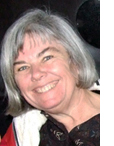 Nancy Harrison Nancy Harrison
cruise & tour specialist
(619) 265-0808
.
SoccerCLEARWATER, Florida--Q: Who is the commissioner of Major League Soccer?
(a) Don Garber
(b) Dan Goldstein
(c) Don Harrison
(d) Dov Markus
Background: He took over as head of MLS in 1999 after 16 years as an executive with the National Football League, including senior vice president of business development and special events. He was producer of Super Bowl halftime shows and an integral part of the creation and development of the NFL Experience theme park at Super Bowls.

Sports Trivia Answer: (
SAN DIEGO JEWISH WORLD THE WEEK IN REVIEW
by Donald H. Harrison in San DiegoSan Diego HistoryDecember 2, 1949:December 2, 1949:December 2, 1949:December 2, 1949:
Arts
SDSU professors probe common origins, traditions of Christianity and Judaism by Fred Reiss in Winchester, California
Thursdays With the Songs of Hal Wingard:
—#45, Love Is The Promise
—#95, Love Is So Elusive
—#174, Porcelain Love
San Diego History
'Adventures' column provides overview of San Diego's Jewish community in late 1940s by Donald H. Harrison in San Diego
Adventures in San Diego Jewish History; articles from the archives
—December 2, 1949: Who's New?
—December 2, 1949: J.C.R.A. by Jeanne Camiel
—December 2, 1949: San Diego Lasker Lodge B’nai B’rith
—December 2, 1949: Temple Men’s Club
International
Former American, now an Israeli, finds faults with both Obama and McCain by Ira Sharkansky in Jerusalem
Former captive nations want to be in NATO by Shoshana Bryen in Washington, D.C.
The Jews Down Under, a roundup of Australian Jewish news by Garry Fabian
—Israeli, Aussie paramedics share knowledge
—High honour for Australian community leader
—Australian Government denies policy shift on Israel
—Maccabi provides Jewish sporting and social networks
—Security concerns about latest technology
—Toben awaits verdict
—Gold Coast school shuts its doors
—Professionals providing community support
—The Promised Land Down Under
—Vorchheimer settles civil claim against authorities
—The Keeper of Memories
Adventures in San Diego Jewish History
—November 18, 1949: American Jewish Congress
—November 18, 1949: Cottage of Israel
—December 2, 1949:Mordecai Kaplan To Be Honored in Los Angeles
—December 2, 1949:Agency Authorizes Fund Campaigns
—December 2, 1949: Beth Jacob P.T.A.
San Diego
Jewish stories at the foot of a hospital bed by Donald H. Harrison in San Diego
Letters
Touching the Soul author touched by review, letter from Max Fallek
Adventures in San Diego Jewish History
—November 18, 1949: Temple Senior League
—November 18, 1949: Temple Beth Israel P.T.A.
—November 18, 1949: Bankruptcy faces Israel, declares Christian minister
—November 18, 1949:Hadassah
—November 18, 1949: Junior Pioneer Women
—November 18, 1949: Temple Beth Israel
International
'Best school in Israel' a matter of survival for planned Sha'ar Hanegev High School by Ulla Hadar in Sha'ar Hanegev, Israel.
San Diego
Why ducks are wary—but not necessarily intimidated—by those human critters by Sheila Orysiek in San Diego
Arts
Surviving and transforming in widowhood, book review by Donald H. Harrison in San Diego
Adventures in San Diego Jewish History
--November 18, 1949: Plans Country Fair For Temple Sisterhood
--November 18, 1949: San Diego Birdie Stodel Chapter B’nai B’rith
--November 18, 1949:Addleson Calls Meeting For Home
--November 18, 1949: 35th Anniversary Observed by Jolly 16
--November 18, 1949:Tifereth Israel Sisterhood
-November 18, 1949: Hadassah Study Group
International
A second- generation scholar promotes food's peace-building possibilities by Donald H. Harrison in San Diego
Judaism
A place to start teshuvah by Rabbi Leonard Rosenthal in San Diego
Sports
A bissel sports trivia by Bruce Lowitt in Clearwater, Florida
Letters
Ginsburg, Maccabi security committee showed high community commitment, from Stuart Simmons in San Diego
Adventures in San Diego Jewish History
—November 18, 1949: Congregation Beth Jacob
—November 18, 1949: S.D. Lasker Lodge
—November 18, 1949:San Diego Hebrew Home for the Aged Auxiliary
—November 18, 1949:Jewish War Veterans Auxiliary
—November 18, 1949: Beth Jacob Ladies Auxiliary
Link to previous editions
< BACK TO TOP
Copyright 2007-2008 - San Diego Jewish World, San Diego, California. All rights reserved. |
|
